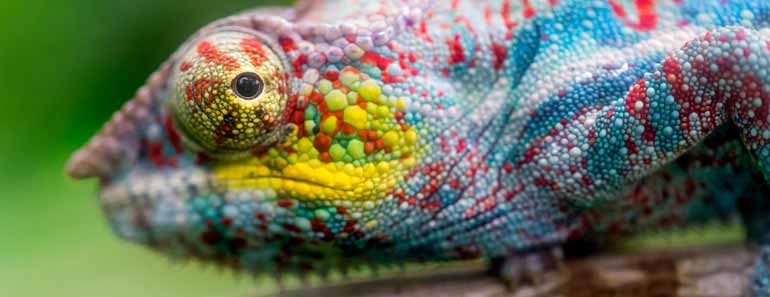
Christopher Anderson, a postdoc associate at Brown University, partnered with National Geographic to share some amazing facts and insights about chameleons, one of the world’s smallest and most colorful reptiles.
- Chameleons are “highly charismatic” – these reptiles have unique physical abilities including eyes that can rotate independently, pincer feet, a long tongue, slow deliberate movements, and of course the ability to change color.
- It’s all about the guanine nanocrystals – not every species of chameleon can change color. Those that can change color have a special layer of skin that contains pigments (black, blue, brown, green, light blue, orange, pink, purple, red, turquoise, and yellow). Beneath that pigment layer is another layer that contains guanine crystals. The spacing of these crystals can be adjusted, shifting light, and causing the color of a chameleon’s skin to change.
- Communication is the primary reason for color changes – the popular myth has been that chameleons change color to avoid predators. Though, scientists have found that chameleons primarily change color for communicating aggression, openness to mating, and more.
- An amazing tongue – a chameleon’s tongue is made up of an array of bone, elastic elements and muscle. Their tongues can be projected up to two full body lengths from their mouths at speeds of up to 4.8m/second (13 mph). If chameleons ate ice cream, they would lick your scoop of rocky road in a blink of an eye.
- They dance a very special cha-cha – as chameleons move, they shift forward and backward with each step in order to mimic the motion of the surrounding leaves and branches. This little dance helps them to blend in with their environment and reduce their visibility to predators.
- A day in the life – most chameleons eat insects and will enjoy a lifespan of 3 to 11 years depending upon their species. They range in length from 5cm all the way up to 60cm. Larger chameleons may also eat other lizards and young birds! There are 202 known species of chameleon and an amazing 42% of these are found in Madagascar.
- Population decline – 36% of the species are endangered. The main threats to chameleons have been attributed to habitat changes like deforestation and similar ecological pressures.
